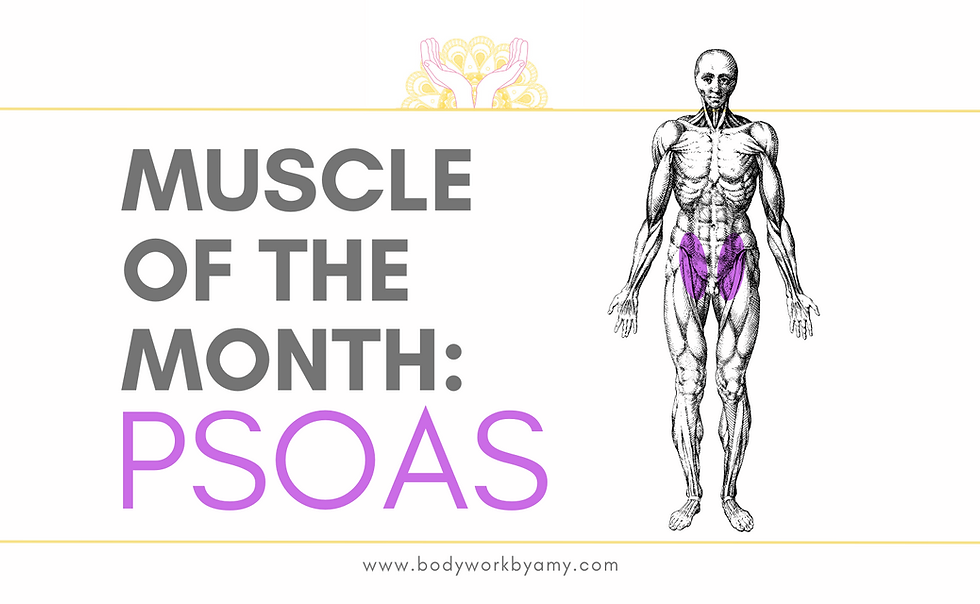Muscle of the Month: Psoas
- Amy

- Jan 10, 2023
- 4 min read

The Iliopsoas is a group of 3 muscles: psoas major, psoas minor, and the iliacus. This group, contracting simultaneously, flexes the hip. It is the deepest of the hip flexors, and possibly the strongest as a muscle group.

In this article, we will examine the anatomy of these 3 amazing muscles, understand their roles and functions, look at how they affect your physical, emotional and spiritual self, and explore some stretches and exercises that can add health and freedom to this vital group of muscles.
But first, a little anatomy:
Iliopsoas, pronounced "ill-ee-oh-SO-az" and the Psoas, pronounced phonetically, "SO-as" since the "p" is silent. The Iliacus can be pronounced: "ill-ee-AH-cus."
1. Psoas Major
ACTIONS: Flex the hip, may laterally rotate the hip, Flex the trunk toward the thigh, Tilt pelvis anteriorly, and unilaterally, it assists to laterally flex the lumbar spine.
ORIGIN: Transverse processes of L1-5, bodies of T12-L5 and intervertebral discs below bodies of T12-L4
INSERTION: Lesser trochanter of femur
NERVE INNERVATION: lumbar plexus of L1 - L4
2. Psoas Minor:
ACTIONS: assist to create lordotic curvature in lumbar spine, tilts pelvis posteriorly.
ORIGIN: body and transverse processes of first lumbar vertebrae
INSERTION: superior ramps of pubis
NERVE INNERVATION: lumbar plexus L1, 2
3. Iliacus:
ACTIONS: flex the hip, may laterally rate hip, flex trunk toward thigh, tilt pelvis anteriorly.
ORIGIN: iliac fossa
INSERTION: lesser trochanter
NERVE INNERVATION: femoral L1, 2, 3, 4

In short, this group is located near the body's center of gravity, buried behind abdominal muscles and your intestines. They begin up at the last rib and continue down to the pelvis. They essentially raise your thigh toward your stomach or bring it forward as to walk or run.
The psoas is a muscle that works with two different joints, making it biarticlulate. It is the only muscle that connects our upper body to the lower body.
It's estimated that about 40% of the population do not have the psoas minor muscle, or only have it on one side. The main difference between the major and minor is that the major is the one that connects the femur (leg) to the spine, whereas the minor connects the pelvis to the spine.
The psoas has a wide range of nicknames including: "hidden prankster," "great pretender," and the "flight or fight muscle." Let us look at why this deep muscle has a somewhat notorious bag of nicknames.
Some of the Pain Symptoms of a dysfunctional or imbalanced Psoas:

hip pain
groin pain
hip impingement
sciatica
SI joint pain
low back pain
restriction in hip socket
iliopsoas tendonitis or bursitis
sway back and anterior pelvic tilt, or "butt out" look
knee pain
hamstring pain
piriformis syndrome
Reaching the psoas:
Because of its proximity to other organs, arteries, and nerves, it is a difficult muscle to reach or palpate. In the image below, you can see that bright aqua blue color, which signifies the iliopsoas. I would advise against you to try and palpate the psoas without proper education, tools, or professional help as it lies deep in your core, and risk or injury is indeed possible.
With that said, I would not suggest having an untrained person to go digging deep in this area either.
From the book, "Trigger Point Therapy for Myofascial Pain," the author gives great suggestions on stretch exercises and strengthening exercises. Side note, this is great book, in general, if you're interested in learning more about the whole body's muscle pain points, and I have linked that book here if interested.
Example of toe raises strengthening exercise- engaging the core and the psoas:

There are TONS of examples of yoga stretches and other exercises on the internet...just be careful to follow credible teachers.

How the psoas plays a role in our energy system and our chakras:
There are 7 basic chakras, or energy centers that exist within the "subtle body" (non-physical), which overlies the physical body. The psoas muscle interconnects the base of spine, or Root Chakra, the second or Sacral Chakra, and the third or Solar Plexus Chakra. When our chakras are balanced, our physical and non-physical self feel balanced.
The psoas plays a vital role in the root chakra, as well as with the quadratus lumborum and the pelvic floor muscles, by helping to stabilize the lumbar and sacral areas. This stabilization is also used for many yoga positions, which can help to connect the body to the mind.
A quote from the book, "The Vital Psoas Muscle," by Jo Ann Staugaard-Jones, wraps up the idea of how yoga, breath work, meditation, and the psoas muscle all work together very well:
"Yoga postures connect the body to the mind.
Breathing connects the mind and body to the unconscious.
Meditation connects the person the universe."
"The Psoas Major connects the upper body to the lower body, linking breath to movement, feelings, energy and healing."

It is clear to see why this muscle group is so important for us to take care of and better understand and appreciate. If you're interested in trying in-home yoga or massage to help stretch this important muscle, feel free to reach out to me to set up a session.
Thanks for reading, and as always, please feel free to message me with questions, comments or concerns.
Thank you and have a great day!
Amy





Comments